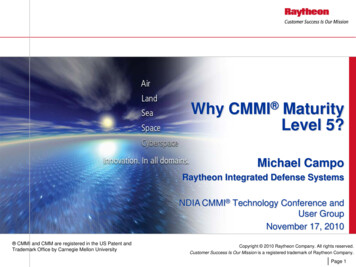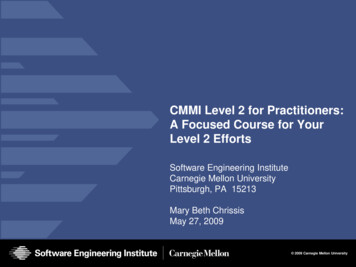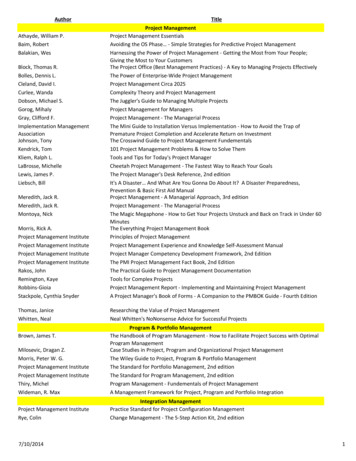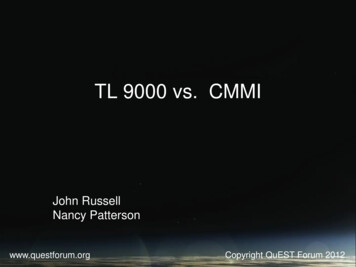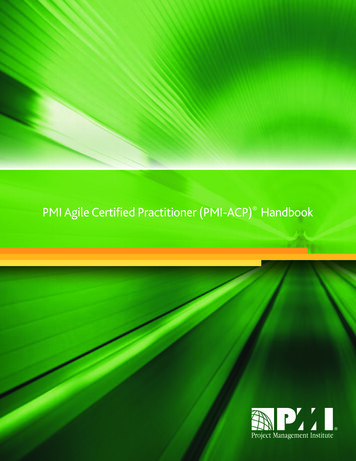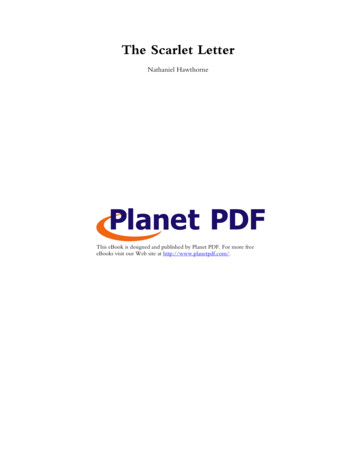
Transcription
November 20, 2017Seema VermaAdministratorCenters for Medicare and Medicaid ServicesU.S. Department of Health and Human ServicesRoom 445–G, Hubert H. Humphrey Building200 Independence Avenue SWWashington, DC 20201Re:Centers for Medicare & Medicaid Services: Innovation Center New Direction Requestfor InformationDear Administrator Verma:On behalf of the American College of Physicians (ACP), I am pleased to share our comments onthe Centers for Medicare and Medicaid Services’ (CMS) Innovation Center New DirectionRequest for Information (RFI). The College is the largest medical specialty organization and thesecond-largest physician group in the United States. ACP members include 152,000 internalmedicine physicians (internists), related subspecialists, and medical students. Internal medicinephysicians are specialists who apply scientific knowledge and clinical expertise to the diagnosis,treatment, and compassionate care of adults across the spectrum from health to complexillness.I.Overarching RecommendationsThe College strongly supports the move to value-based payment and the role that the Centerfor Medicare and Medicaid Innovation (CMMI) plays in designing, testing, and implementingnew payment models that move health care toward this goal. As ACP notes in our recent paper1outlining the College’s forward-looking agenda, the College supports continued implementationof Medicare’s new Quality Payment Program (QPP), as established by MACRA, andimprovements to make it more meaningful for clinicians and patients, including the creationmore opportunities for physician-led alternative payment models (APM). Along these lines,ACP has been active in providing feedback on the implementation of the QPP via its letters onboth the 2017 and 2018 proposed rules, as well as on the Measure Development Plan andother requests for information and feedback from the Agency. ACP encourages CMMI tocontinue to accelerate the transition from fee-for-service (FFS) payment systems to bundled1https://www.acponline.org/acp policy/policies/forward looking policy agenda 2017.pdf
and risk-adjusted capitation payments, hybrid FFS bundled/capitated payments, and otherpayment systems that incentivize value rather than volume. Our key APM recommendationsfocus on: Continuing flexibility and a phased-in approach to participation that will allow physiciansand other clinicians to be successful;Allowing multiple pathways for patient-centered medical homes (PCMHs) to qualify asAdvanced APMs, including options that do not require physicians to bear more thannominal financial risk; andPrioritizing the testing of models involving physician specialty/subspecialty categoriesfor which there are no current recognized APM/Advanced APM options.In recognition that all clinicians are not willing or able to move directly into models withsignificant payment at risk, there should be pathways to help clinicians transition to modelswith increasing levels of risk at stake. Additionally, ACP encourages CMS to develop anexpedited process for CMMI to develop, test, and expand APMs. This should include a pathwayfor testing models recommended by the Physician-Focused Payment Model Technical AdvisoryCommittee (PTAC), as well as models from Medicaid and private payers.CMMI “New Direction” Guiding PrinciplesThe College’s comments below on these guiding principles are summaries of what is furtheroutlined in our remarks on the potential models in section II of this letter. There are a numberof components of these principles that ACP supports; however, we also have significantconcerns about some of the language used in terms of what it will mean for theimplementation of the key concepts. For instance, as discussed further below, promotingpatient choice and competition is a laudable goal, but the current measurement systems andmeans of sharing the information with consumers are simply not ready to support a rapidimplementation of that approach. We therefore recommend that the Agency proceed withgreat care to ensure that patients and their families do not experience unintended negativeconsequences by relying on potentially flawed or unclear data to choose a clinician or type ofpayment structure.1. Choice and competition in the market – Promote competition based on quality,outcomes, and costs.ACP supports transparency of valid and reliable information, including quality, outcomes, andcost data. We agree that this potentially can have the result of empowering consumers,physicians, payers, and other stakeholders to reduce health care spending and improve qualityof care. However, the College recommends caution in terms of moving too quickly towardsystems that depend significantly on consumer choice based on quality, outcome, and costdata. The currently available performance measures, measurement systems, and means ofsharing performance information with consumers, which would be the basis for and means ofpatients and families making their health care decisions, are not adequate. Until qualitymeasures are developed that appropriately assess high priority areas and improved patient2
outcomes, patients will not have valid and reliable data available with which to properly assessquality. These data also need to be provided to patients and their families in usable and usefulformats for decisionmaking. In announcing new initiatives related to “Meaningful Measures”and “Patients Over Paperwork,” CMS Administrator Seema Verma acknowledges the challengeswith administrative tasks, regulatory burdens, and the quality measures that currently are usedby Medicare—and ACP is hopeful that the work under those initiatives can lead to anenvironment that would eventually be able to support a greater, and more informed, ability ofconsumers to make choices based on quality and cost.2. Provider Choice and Incentives – Focus on voluntary models, with defined andreasonable control groups or comparison populations, to the extent possible, andreduce burdensome requirements and unnecessary regulations to allow physicians andother providers to focus on providing high-quality healthcare to their patients. Givebeneficiaries and healthcare providers the tools and information they need to makedecisions that work best for them.The College agrees that physician participation in payment models of their choice should bevoluntary. ACP also understands the need to have defined control groups or comparisonpopulations to allow proper analysis of the effectiveness of models in improving quality anddecreasing costs. However, we recommend that CMS make every effort to minimize theamount of qualified APM applicants who are randomized into control groups and thereforeunable to benefit from enhanced payments or other potential incentive payments thatparticipants in the model receive.Additionally, ACP strongly supports efforts to reduce burdens and unnecessary regulatoryrequirements, as outlined in ACP’s policy paper titled, “Putting Patients First by ReducingAdministrative Tasks in Health Care,”2 which was published in Annals of Internal Medicine inMarch 2017 and recently supported by the American Congress of Obstetricians andGynecologists. This will better allow participants in APMs to make the transformationalpractice changes needed to test new and innovative ways to deliver better quality care at lowercosts. Physicians and patients must also have the tools and information that they need—inusable and useful formats—to make informed decisions about participation in new paymentmodels and benefit designs.3. Patient-centered care – Empower beneficiaries, their families, and caregivers to takeownership of their health and ensure that they have the flexibility and information tomake choices as they seek care across the care continuum.ACP strongly supports patient-centered care as it needs to be the critical underpinning of alldelivery systems and payment models, whether they are APMs or not. This is why the Collegehas long advocated for testing and implementation of the Patient-Centered Medical health-careposition-paper3
(PCMH) model and the Patient-Centered Medical Neighborhood/Patient-Centered SpecialtyPractice model3—both of which are incentivized in various ways within the Quality PaymentProgram. Additionally, as the College has recommended in numerous comment letters, CMSmust work to ensure that patients, families, and the relationship of patients and families withtheir physicians are at the forefront of the Agency’s thinking in the development of both theMerit-based Incentive Payment System (MIPS) and APM pathways.However, the College does have significant concerns with the language within this principle interms of how it may ultimately be operationalized. As noted above, current quality and costmeasures and the system used to collect and share the data from these measures are simplynot adequate at this time. Again, ACP calls on CMS to move forward with caution in terms ofdeveloping and implementing programs that depend significantly on consumer choice based onquality, outcomes, and cost. Otherwise, there is a real risk of patients experiencing pooroutcomes and even harm if they are making decisions based on potentially flawed or unclearinformation. Additionally, patient participation in such programs should be voluntary, andparticipants in models should not have financial penalties imposed simply for failing to achievehealth goals and outcomes.As discussed in more detail in this letter under CMS’s proposals for Consumer-Directed Care &Market-Based Innovation Model, ACP has major concerns that models that impose coveragelimitations or financial penalties on patients who fail to meet health goals willdisproportionately hurt poorer patients (such as Medicare-Medicaid dual eligibles) who cannotafford to contribute additional out-of-pocket funding to their care. Patient-centered careshould help patients, especially poorer patients with the greatest need, improve their health,not punish them if they are unable to achieve better outcomes, especially when personal andpopulation-based health outcomes are largely determined by social determinants that arebeyond the patient’s control.4. Benefit design and price transparency – Use data-driven insights to ensure costeffective care that also leads to improvements in beneficiary outcomes.ACP’s newly released position paper on “Improving Health Care Efficacy and Efficiency ThroughIncreased Transparency”4 provides detailed recommendations that CMS should consider interms of operationalizing this principle. In this paper, the College outlines our support fortransparency of reliable and valid price information, expected out-of-pocket costs, and qualitydata that allows consumers, physicians, payers, and other stakeholders to compare and assessmedical services and products in a meaningful way. However, it is also important to note thatprice should never be used as the sole criterion for choosing a physician, other health careprofessional, or health care service. Additionally, payers, plans, and other health care ments/advocacy/current policy papers/assets/pcmh neighbors.pdf4https://www.acponline.org/acp policy/policies/improving health care efficacy and efficiency through increased transparency 2017.pdf4
zations must work to develop patient-targeted health care value decision-making tools that arewritten for patients at all levels of health literacy that make price, estimated out-of-pocket cost,and quality data available to consumers. And, as noted earlier, this information should becommunicated in an easy-to-understand way.5. Transparent model design and evaluation – Draw on partnerships and collaborationswith public stakeholders and harness ideas from a broad range of organizations andindividuals across the country.The College supports the need for transparency in model design and for CMS to collaboratewith a broad range of stakeholders—and would strongly recommend that those stakeholdersinclude specialty societies, frontline clinicians, and patients and families. Stakeholdercollaboration should be incorporated into the development, testing, and implementation ofalternative payment models with a focus on ensuring that those models are truly leadingtoward improved quality and value that is meaningful not only to payers and clinicians, but alsoto patients and their families.Further, collaboration with stakeholders is a critical component of decreasing unnecessaryadministrative tasks that lead to clinician and patient burden. This is why ACP has beenconducting outreach as part of our Patients Before Paperwork initiative5 to engage keystakeholders, including CMS, in collaborative discussions and activities to address thefundamental components of successful delivery and payment models, such as improving EHRinteroperability and usability, addressing problems with the current performance measurementsystem, and reducing tasks that may no longer be necessary within a value-based paymentsystem focused on patient outcomes (e.g., certain prior authorization requirements).6. Small Scale Testing – Test smaller scale models that may be scaled if they meet therequirements for expansion under 1115 A(c) of the Affordable Care Act (the Act). Focuson key payment interventions rather than on specific devices or equipment.The College supports testing smaller scale models and using 1115A(c) authority to expandmodels that prove successful. However, we note that testing on a more limited scale restrictsthe number of physicians who can participate in Advanced APMs. CMS should take steps toexpedite reviews of models that are undergoing small-scale testing and take immediate steps toexpand the models should data show that it meets the criteria under 1115A(c). As noted later inour comments on expanded Advanced APM opportunities, few primary care physicians have apatient-centered medical home (PCMH) option available in the Advanced APM pathway due tosmall-scale testing. CMS should take steps to accelerate review of the Comprehensive PrimaryCare Initiative (CPCi) and Comprehensive Primary Care Plus (CPC ) models and expand themnationally should the data meet the 1115A(c) expansion e-we-stand/patients-before-paperwork5
II.Potential Models1. Expanded Opportunities for Participation in Advanced APMsCMS Proposal:In April 2015, Congress passed the Medicare Access and CHIP Reauthorization Act of 2015(MACRA) that repealed the Sustainable Growth Rate formula for updating the Medicarephysician fee schedule, and replaced it with a series of fixed statutory updates and a QualityPayment Program that includes the Merit-Based Incentive Payment System (MIPS) andAdvanced APMs. CMS administers the Quality Payment Program, and the Innovation Centerbears primary responsibility for development of policies and operations relating to AdvancedAPMs. Eligible clinicians who are Qualifying APM Participants (QPs) for a year from 2019through 2024 receive a lump sum APM incentive payment and, beginning for 2026, adifferentially higher update under the Medicare physician fee schedule. Eligible clinicians whoare QPs for a year are also not subject to the MIPS reporting requirements and paymentadjustment.CMS expects that the number of eligible clinicians choosing to participate in Advanced APMswill grow over time. To facilitate this growth, CMS seeks comment on ways to increaseopportunities for eligible clinicians to participate in Advanced APMs and achieve thresholdlevels of participation to become QPs. CMS has received feedback from the healthcare providercommunity on the extensive and lengthy process that is required for a model to qualify as anAdvanced APM. CMS seeks feedback from stakeholders on ways the Administration can bemore responsive to eligible clinicians and their patients, and potentially expedite the processfor providers that want to participate in an Advanced APM. CMS also seeks guidance from thestakeholders on ways to capture appropriate data to drive the design of innovative paymentmodels and strategies to incentivize eligible clinicians to participate in Advanced APMs.ACP Comments:As noted above, ACP strongly supports expanding the options that are available for internalmedicine physicians and subspecialists to participate in value-based models through theAdvanced APM pathway. Currently, there are few APMs available for internal medicinephysicians, especially subspecialists, to participate in through the Innovation Center, and thosethat include the most participants, such as the Medicare Shared Savings Program ACOs in Track1, do not even qualify as Advanced APMs due to strict financial risk requirements. ThoseAdvanced APMs that are available are often very limited in scope and only allow participants incertain regions or who meet very limited criteria. Many specialists and subspecialists lack anyAdvanced APMs that are relevant to their specialization. And for primary care physicians, apatient-centered medical home model that is an Advanced APM simply is not available yet.ACP recommends that CMMI take into account a number of options and considerations tomake Advanced APMs more readily available including:6
Expand opportunities for primary care physicians to participate in medical homemodels as Advanced APMs. Additional medical home models should include bothmodels that meet the medical home model nominal amount standard, as well as byusing 1115A(c) authority to expand PCMH models that do not have a nominal riskrequirement. The details of ACP’s recommendations regarding medical home optionscan be found in our comments on the 2018 QPP rule.6o In this context, the College also would like to re-iterate our strong support forthe Comprehensive Primary Care Plus (CPC ) program. As indicated in ourNovember 8, 2017 testimony before the Energy and Commerce HealthSubcommittee on “MACRA and Alternative Payment Models: DevelopingOptions for Value-based Care,”7 ACP believes that CPC offers the potential ofgreatly strengthening the ability of internists and other primary care clinicians, inthousands of practices nationwide, to deliver high value, high performing,effective, and accessible primary care to millions of their patients. The successof this program will depend on Medicare and other payers providing physiciansand their practices with the sustained financial support needed for them to meetthe goal of providing comprehensive, high value, accessible, and patientcentered care, with realistic and achievable ways to assess each practices’impact on patient care. The College is committed to working with CMS on theongoing implementation of this program to ensure that it is truly able to meetsuch requirements of success. Further, ACP recognizes that, in addition to CPC being a currently available advanced APM, it is also an ongoing research projectwhose methodology needs to be as sound as feasibly possible. Therefore, anynew primary care programs that are to be tested by CMMI should be conductedin such a way as to not negatively impact the CPC methodology.Apply medical home model standards to specialty practice models. On the MIPS side,certified/recognized PCMHs and comparable specialty practice models are treated thesame when it comes to receiving full credit for improvement activities. For APMs, CMSshould allow comparable specialty practice models that are Advanced APMs to qualifyfor the medical home model nominal amount standard as well as utilize the non-riskbearing standard for PCMHs that meet the criteria for expansion under 1115A(c).Eliminate arbitrary limits on number of clinicians in an organization to be consideredan Advanced APM. We urge CMS to remove any limitations on Medical Home Modelsbased on the number of clinicians in the organization that owns and operates thepractice site. A TIN may have many practice sites under it but only one or two that areprimary care and therefore able to be recognized PCMHs—or, more specifically, CPC practices. These practice sites are then not able to receive the bonus payments for being6https://www.acponline.org/acp policy/letters/cms comment letter re cy 2018 macra qpp proposed rule 2017.pdf7https://www.acponline.org/acp policy/testimony/statement house energy commerce health subcommittee hearing on macra and apms 2017.pdf7
an advanced APM when they are performing the same functions as other CPC practices.Maintain or reduce nominal amount standards for risk to create stability as modelsare being developed. Groups that are designing APMs expend significant time andresources during the development process, potential review by the PTAC, and possiblework with CMS to further refine and implement. By the time this process, which cantake years, is completed and a model is being tested, nominal amount standards willlikely have changed or increased over what they were during the development process.In order to expand the available Advanced APMs, CMS should at a minimum maintainthe current nominal amount standards indefinitely so that groups developing modelsknow what risk target they need to meet. To bring models and participants into the foldmore rapidly, a reduction in the arbitrary nominal amount standards should beconsidered.Consider adding flexibility to the nominal risk standards for other-payer AdvancedAPMs. Models that are being implemented by other payers often do not necessarily fitneatly within the CMS-defined nominal amount standard for Medicare Part B models aswell as other design structures in Medicare models. More flexible standards for otherpayer APMs will expand options for participating in Advanced APMs.Create lower nominal amount standard for models focused on small practices andthose in rural areas and health professional shortage areas (HPSAs). In recognition ofthe challenges that small and rural practices face in accepting the general nominalamount standard of risk, CMS should allow these practices to join Advanced APMsunder a lower nominal risk standard (e.g., the medical home model standard). Thiswould include small and rural practices that are part of a medical home model andthose that join larger APM entities.Consider the upfront costs of participating in APMs as well as the ongoingmaintenance costs when determining whether models meet nominal financial riskcriteria. Significant “at risk” capital requirements are necessary to start and maintainAPMs such as ACOs. The College reaffirms its belief that Track One MSSP ACOs shouldqualify as meeting the nominal risk requirement for determining an Advanced APM. Thisposition was more fully articulated in a joint comment letter signed-onto by the Collegedated March 25, 2016.8Ensure that reporting and other administrative tasks within current and new advancedAPMs are developed, implemented, and monitored in a manner that ensures they donot add unnecessary burden to the clinician practice and/or to their patients andfamilies. This approach is aligned with the Administration’s recently announced“Patients Over Paperwork” initiative and with the College’s “Patients BeforePaperwork”9 initiative that has been in place since 2015, as well as our policy paper“Putting Patients First by Reducing Administrative Tasks in Health Care.”108https://www.acponline.org/acp policy/letters/joint comment mssp aco benchmarki ng paper98
2. Consumer-Directed Care & Market-Based Innovation ModelsCMS Proposal:CMS believes beneficiaries should be empowered as consumers to drive change in the healthsystem through their choices. Consumer-directed care models could empower Medicare,Medicaid, and CHIP beneficiaries to make choices from among competitors in a market-drivenhealthcare system. To better inform consumers about the cost and quality implications ofdifferent choices, CMS may develop models to facilitate and encourage price and qualitytransparency, including the compilation, analysis, and release of cost data and quality metricsthat inform beneficiaries about their choices. CMS will consider new options for beneficiaries topromote consumerism and transparency. For example, beneficiaries could choose toparticipate in arrangements that would allow them to keep some of the savings when theychoose a lower-cost option, or that incentivize them to achieve better health. Models that weare considering testing include allowing Medicare beneficiaries to contract directly withhealthcare providers, having providers propose prices to inform beneficiary choices andtransparency, offering bundled payments for full episodes of care with groups of providersbidding on the payment amount, and launching preferred provider networks. CMS solicitsfeedback from patient and consumer advocacy groups, the healthcare provider community, aswell as experts in the technology industry, and other stakeholders that can provide creativeideas on how to operationalize these principles in models that best serve patients in terms ofcost, quality, and access to care.ACP Comments:As discussed earlier in our comments on the Guiding Principles, the College recommendscaution in terms of moving too quickly toward systems that depend significantly on consumerchoice based on quality, outcomes, and cost. The currently available performance measures,measurement systems, and means of sharing performance information with consumers, whichwould be the basis for and means of patients and families making their health care decisions,are not adequate. Until quality measures are developed that appropriately assess high priorityareas and improved patient outcomes, patients will not have valid and reliable data availablewith which to properly assess quality—and then these data also need to be provided topatients and their families in usable and useful formats for decision-making. In announcingnew initiatives related to “Meaningful Measures” and “Patients Over Paperwork,” CMSAdministrator Seema Verma acknowledges the challenges with administrative tasks, regulatoryburdens, and the quality measures that currently are used by Medicare—and ACP is hopefulthat the work under those initiatives can lead to an environment that would eventually be ableto support a greater, and more informed, ability of consumers to make choices based on qualityand cost.9
As outlined in ACP’s newly released paper titled “Improving Health Care Efficacy and EfficiencyThrough Increased Transparency,”11 price should never be used as the sole criterion in choosinga clinician, health care service, health plan, or payment model. Therefore, transparency ofreliable and valid price information, expected out-of-pocket costs, and quality data that allowsconsumers, physicians, payers, and other stakeholders to compare and assess medical servicesand products in a meaningful way is critical.Along these lines, the College recommends that CMS and other stakeholders work together toensure proper patient education and that health literacy efforts are undertaken to promotebetter, more accessible, and objective information about any cost and quality information, costsharing requirements, patient incentives, etc. that may be associated with a beneficiarychoosing to participate in a model. Comparison data on quality and price must be available in aformat that allows consumers to directly compare performance across entities. CMS shouldalso consider partnering with advocacy groups to host listening sessions and provide othermaterials to ensure that consumers are educated on new models and their potential impact ontheir care and relationships with physicians. More broadly, patient representatives should havea role in discussions related to benefit design, payment model development, and relatedpatient education efforts.The College also recommends that CMS consider supporting the development of all-payerclaims databases (APCDs), which can play an important role in standardizing information thatcan be analyzed for use in APM development and price transparency. These databases shouldbe setup in a manner that they can be expanded to incorporate information beyond claims suchas qualified clinical data registry (QCDR) and vital statistics information.ACP does not support Consumer-Directed Care and Market-Based Innovation Modelsthat would “incentivize them [patients] to achieve better health” if that means penalizingpatients who are unable to achieve desired health outcomes. While the College supportsvoluntary models that offer the support needed to help patients achieve better health, such asno-cost access to evidence-based smoking cessation, weight loss, and care coordinationservices, such must models not penalize patients that fall short of meeting desired health goalsand outcomes. Models that would impose coverage limitations, financial penalties, or reducedaccess to care for failure to achieve health goals will disproportionately impact poorer patientswho lack funds to pay for the additional out-of-pocket costs that may be imposed. Socialdeterminants of health such as socioeconomic status, inadequate housing and transportation,lack of access to healthy foods, and racial and ethnic health disparities are known to negativelyimpact patients’ health. Accordingly, Consumer-Directed and Market-Based Innovation Modelsmust not punish patients by withholding benefits or imposing financial penalties on them forbehaviors or actions that may be associated with social determinants that are largely beyondtheir control. Models should recognize these factors and seek to identify causes, effects, and11https://www.acponline.org/acp policy/policies/improving health care efficacy and efficiency through increased transparency 2017.pdf10
methods prevention of social determina
Benefit design and price transparency - Use data-driven insights to ensure cost-effective care that also leads to improvements in beneficiary outcomes. AP's newly released position paper on "Improving Health are Efficacy and Efficiency Through Increased Transparency"4 provides detailed recommendations that CMS should consider in
